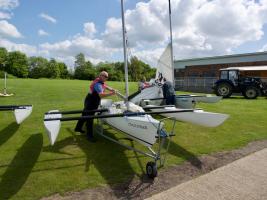Lt Commander Tricia Davies - Life as a Wren (Partners)
Tue, Apr 17th 2018 at 7:30 pm - 10:00 pm
Lt Commander Tricia Davies - Life as a Wren (Partners)
Club members please log in for more information.
Women's Royal Naval Service
The Women's Royal Naval Service (WRNS; popularly and officially known as the Wrens) was the women's branch of the United Kingdom's Royal Navy. First formed in 1917 for the First World War, it was disbanded in 1919, then revived in 1939 at the beginning of the Second World War, remaining active until integrated into the Royal Navy in 1993. WRNs included cooks, clerks, wireless telegraphists, radar plotters, weapons analysts, range assessors, electricians and air mechanics.
History
The Wrens were formed in 1917 during the First World War. On 10 October 1918, nineteen-year-old Josephine Carr from Cork, became the first Wren to die on active service, when her ship, the RMS Leinster was torpedoed. By the end of the war the WRNS had 5,500 members, 500 of them officers. In addition, about 2,000 members of the WRAF had previously served with the WRNS supporting the Royal Naval Air Service and were transferred on the creation of the Royal Air Force. It was disbanded in 1919.
The WRNS was revived in 1939 at the beginning of the Second World War, with an expanded list of allowable activities, including flying transport planes. At its peak in 1944 it had 75,000 active servicewomen. During the war there were 100 deaths. One of the slogans used in recruiting posters was "Join the Wrens—free a man for the fleet."
In the 1970s it became obvious that equal pay for women and the need to remove sexual discrimination meant that the WRNS and the Royal Navy would become one organisation. The key change was that women would become subject to the Naval Discipline Act 1957. Vonla McBride who had experience in Human resource management became the Director of the WRNS in 1976 and members of the WRNS were subject to the same discipline as men as of 1977.[1]
The WRNS remained in existence after the war and was finally integrated into the regular Royal Navy in 1993 when women were allowed to serve on board navy vessels as full members of the crew. In October 1990, during the Gulf War, HMS Brilliant carried the first women to officially serve on an operational warship.[2]
Before 1993, all women in the Royal Navy were members of the WRNS except nurses, who joined (and still join) Queen Alexandra's Royal Naval Nursing Service, and medical and dental officers, who were commissioned directly into the Royal Navy, held RN ranks, and wore WRNS uniform with gold RN insignia. Female sailors are still known by the nicknames "wrens" or Jennies ("Jenny Wrens") in naval slang.
Ranks and uniform
The WRNS had its own ranking system, which it retained until amalgamation into the Royal Navy in 1993.
| 1917–1919 ranks | 1939–1993 ranks | |||
|---|---|---|---|---|
| Officers | Ratings | Commissioned Officers | ||
| WRNS rank | WRNS rank | Equivalent RN rank | WRNS rank | Equivalent RN rank |
| Assistant Principal | Ordinary Wren | Ordinary Seaman | Third Officer | Sub-Lieutenant |
| Deputy Principal | Wren | Able Seaman | Second Officer | Lieutenant |
| Principal | Leading Wren | Leading Seaman | First Officer | Lieutenant-Commander |
| Deputy Divisional Director | Petty Officer Wren | Petty Officer | Chief Officer | Commander |
| Divisional Director | Chief Wren | Chief Petty Officer | Superintendent | Captain |
| Deputy Assistant Director |
|
|
Director (until 1951)
Commandant (from 1951)[3] |
Rear-Admiral (until 1946)
Commodore (from 1946) |
| Assistant Director |
|
|
Commandant (until 1951)
Chief Commandant (from 1951)[4] |
Rear-Admiral |
| Deputy Director |
|
|
|
|
| Director |
|
|
|
|
Ratings' titles were suffixed with their trade (e.g. Leading Wren Cook, Chief Wren Telegraphist).
Wrens wore the same rank insignia as their male equivalents, but in blue instead of gold. The "curls" atop officers' rank stripes were diamond-shaped instead of circular.
From 1939, Wren uniform consisted of a double-breasted jacket and skirt, with shirt and tie, for all ranks (although similar working dress to the men could also be worn). Junior Ratings wore hats similar to those of their male counterparts (although with a more sloping top). Senior Ratings (Petty Officers and above) and officers wore tricorne hats with a white cover. All insignia, including cap badges and non-substantive (trade) badges, were blue.
'What We Do' Main Pages:
Each edition includes updates, upcoming events, and stories from our community. It serves as a bridge connecting us all and celebrates our successes.
moreClub Members supporting The Kimbolton Fayre - Admissions and the sale of Raffle Tickets for the Grand Draw
more
The Keech Hospice provides medical, physical, practical and emotional care and support, over the phone, in the comfort of your own home, in the community or at their specialist care centres in Luton and Bedford.
moreNew Members and New Forms of Membership
more
Members of the Rotary Club of Bedford Castle volunteers attend the Bedford Food Bank each week to assist in sorting the food donations ready for delivery
more
An Annual Competition held in Bedford for Young and aspiring Musicians, sponsored by the Rotary Clubs of Bedford
more
The Rotary Club of Bedford Castle has over many years sponsored many young people to attend the Rotary Youth Leadership Courses
more
Every year the Rotary Club provides opportunities for adults and young people to build confidence and self-esteem by taking part in adventurous outdoor activities at the Calvert Trust's facility in the Lake District
more
The Rotary Club of Bedford Castle are working together with students and staff from Bedford Academy to raise funds for much needed equipment.
more
BookTastic, Bedford’s Children’s Book Festival, brings the UK’s leading writers and illustrators to Bedford, inspiring children and encouraging them to engage with books and reading in an exciting and accessible way.
moreBedford Castle Rotary Club put a great deal of effort into raising money for good causes. Over the past few years we have made charitable donations to the following:-
moreGarden Improvement Project
more
.jpg)
.jpg)
.jpg)
.jpg)
.jpg)
.jpg)
.jpg)
.jpg)
.jpg)
.jpg)
.jpg)
.jpg)
.jpg)


